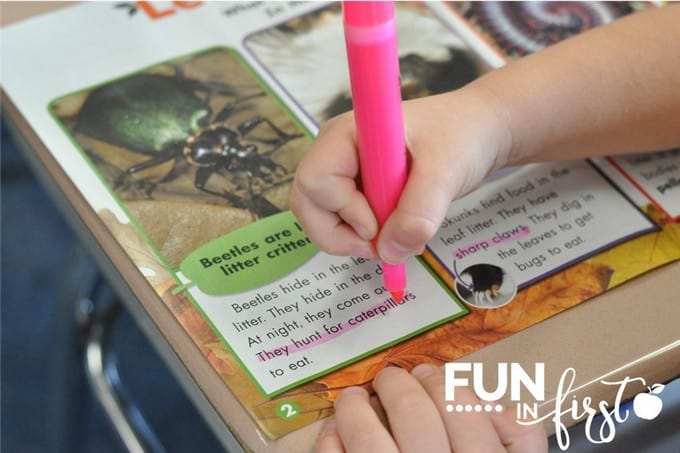

Thank you to Scholastic for sponsoring this post to help spread the word about Scholastics Magazines. All opinions are my own, and I only share about products I love.
I received the October set of Scholastic News magazines for Grade 1, and the topics were perfect for our classroom. (Pumpkins, Fire Safety, Animals in Leaf Litter, and Elections) They were so easy to incorporate right into our day. The students were so excited to have their own magazines with real pictures.

We read the article together and discussed the things we learned. Then, I had the students highlight anything new that they learned from the article. They loved going back into the text to look for new knowledge.
Next, I displayed the poster size copy of the article on my easel.

We reread the article and discussed the main idea and key details in the text. This particular article was perfect for this nonfiction skill. I had the students come up and place a Post-It note on each part.

Later on in the week, after we had read some of the other magazines for the month, we talked about nonfiction text features. I placed my students into small groups of 4-5. I wanted them to create their own anchor charts to show different text features. I gave each group a large piece of Scholastic Weekly Readers, and labels. {You can download the labels for free HERE.}

I have to admit, I was a little worried about this at first. I explained over and over again that they needed to work together and plan out their charts. I tried to explain to my students that they did not want to just start cutting and gluing. They would have to come up with a plan as to where to place things before they glued everything down.

I eventually just let go of the control of wanting a “pretty” anchor chart and allowed them to plan and learn from their mistakes. I was SO pleasantly surprised!

Their end results were amazing. We only had one group that accidently threw away two of their text feature labels, so they left them off of the chart. One group out of 5…I call that success.

I was so proud of them. They really took ownership of these anchor charts. Their learning from this activity will be so much stronger than if I created the anchor chart and just placed it on my wall.

The students love these magazines, and I will definitely be ordering them for the remainder of the school year. The possibilities are endless. I also love that they come with posters, online tools, and lesson ideas.

Scholastic believes that students learn when educational topics are meaningful to them. That’s why each Scholastic Classroom Magazine takes a specific subject like math or language arts and uses captivating photos, informative writing, and impressive online features to make it relevant and engaging to every student. Not only do students love Scholastic Magazines, teachers love using them in their classrooms because they provide invaluable instructional materials that meet current academic standards that prepare students for state tests.
I also love that a Scholastic Magazine subscription includes access to Scholastic News Online, which features exciting videos, learning games, Text-to-Talk audio, and so much more.
You could win a $200 gift card from the Scholastic Teacher Store!
Scholastic Magazines is hosting a #SmartTeachingTips contest for other teachers to develop their own creative ideas on how to incorporate Scholastic Magazines into the classroom.
How to enter the #SmartTeachingTips Contest.
Share your tips for how to use Scholastic Magazines creatively in your classroom. Tell about it on Facebook, Twitter, Pinterest, or Instagram, and include a photo or video. Be sure to use the hashtag #SmartTeachingTips.
Three winners will be chosen based on outstanding creativity. Each winner will receive a $200 gift card to Scholastic Teacher Store. Follow Scholastic Teachers on social media to learn more.
@scholasticinc on Instagram
30 Day Free Trial of Scholastic Printables
Lessons and activities on other websites can be unreliable and inaccurate. Only Scholastic Printables has a team of education experts to ensure you’re getting the highest-quality, most up-to-date resources available for grades PreK-6! Start your free 30 days now!
Scholastic Magazines – Promotional Code
Scholastic Magazines are the most affordable and exciting way to bring current, curriculum connected nonfiction into your classroom. To save 40%, mention code 2905 when ordering. Call 1-800-SCHOLASTIC or visit www.scholastic.com/magazines.
I would love to hear how you use Scholastic Magazines in your classroom.
Original article and pictures take http://funinfirst.com/scholastic-weekly-reader/ site
Комментариев нет:
Отправить комментарий